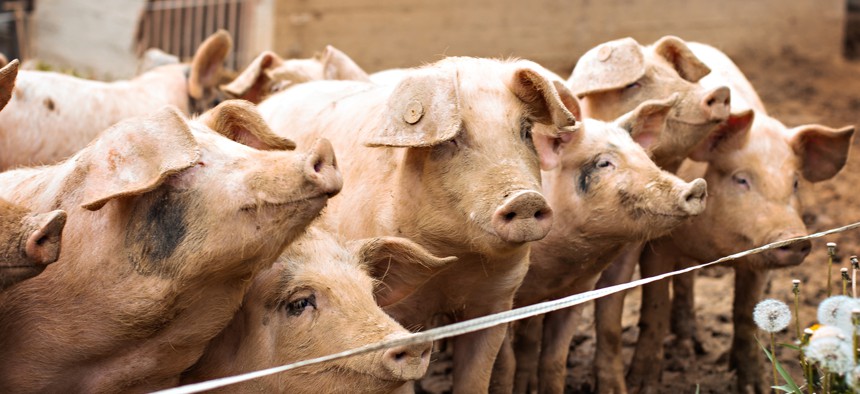Unions and Nonprofit Sue USDA Over New Hog Slaughter Rule
The rule, which goes into effect on Dec. 2, gives producers more control over meat inspections.
Citing worker safety concerns, unions and a nonprofit group are suing the Agriculture Department to block a new rule, set to take effect on Dec. 2, that would give the pork industry more leeway in meat inspections.
The “Modernization of Swine Slaughter Inspection” rule promulgated by the Food Safety and Inspection Service, a division of the Agriculture Department, will allow pork producers to set the speed limits on inspection lines and shift more responsibilities to the companies, if they choose to opt in. The United Food and Commercial Workers International Union, which has over 1.3 million members, and its locals in Minnesota, Iowa and Kansas, along with Public Citizen, a consumer advocacy nonprofit, filed the lawsuit against USDA on Oct. 7 in the U.S. District Court for the District of Minneapolis. Citing violations of the Administrative Procedures Act, the plaintiffs are seeking to prevent USDA from implementing the rule.
USDA anticipates that about 40 high-volume hog slaughter establishments, which account for 93% of the total annual production, will opt into the new system, according to the rule.
For more than three decades, federal rules have linked the speed of slaughter lines to the number of government inspectors on site, said the complaint, noting: “The rule entirely eliminates maximum line speeds and reduces the number of government-employed ‘online’ safety inspectors on the lines by 40%, instead allowing the plants to use their own employees—with no required training—to monitor compliance with health and safety standards.”
One of the plaintiffs’ attorneys, Adam Pulver, of Public Citizen Litigation Group, told Government Executive that increased line speeds can lead to stress fractures, cuts and amputations, which are already significant issues in the meatpacking industry. He said this falls in line with the Trump administration's push to “allow companies to self-regulate.”
Meanwhile, the rule says this will “make better use of the agency's resources and remove unnecessary regulatory obstacles to industry innovation by revoking maximum line speeds and allowing establishments flexibility to reconfigure evisceration lines.” FSIS estimated about $52 million in annual savings from the rule.
The government’s legal team would not comment on the ongoing lawsuit, but Deputy Under Secretary for Food Safety Mindy Brashears wrote in Food Safety News on Sept. 19 that the rule has been in the works for four administrations and “has key provisions based on science to improve food safety that are getting overlooked by those that oppose modernization efforts.”
Pulver maintains that “USDA refused to consider the impact of its actions on worker safety in issuing the final rule by pointing to the existence of [the Occupational Safety and Health Administration].”
A spokesperson for the Labor Department, OSHA’s parent department, told Government Executive, “OSHA does not have jurisdiction over line speed. Employers are required to provide their employees with a place of employment that is free from health and safety hazards.”
USDA’s inspector general in June launched an investigation into the department’s rulemaking process after 17 members of Congress requested one. The probe includes “USDA’s conduct throughout the rulemaking, including its failure to disclose the data it relied upon in the [notice of proposed rulemaking] and the flawed analysis it undertook,” according to the complaint.
Although the rule goes into effect on Dec. 2, all hog market establishments have until March 20, 2020 to notify their FSIS district office of their decision on the new system. The government has until Dec. 6 to file its response to the lawsuit.








